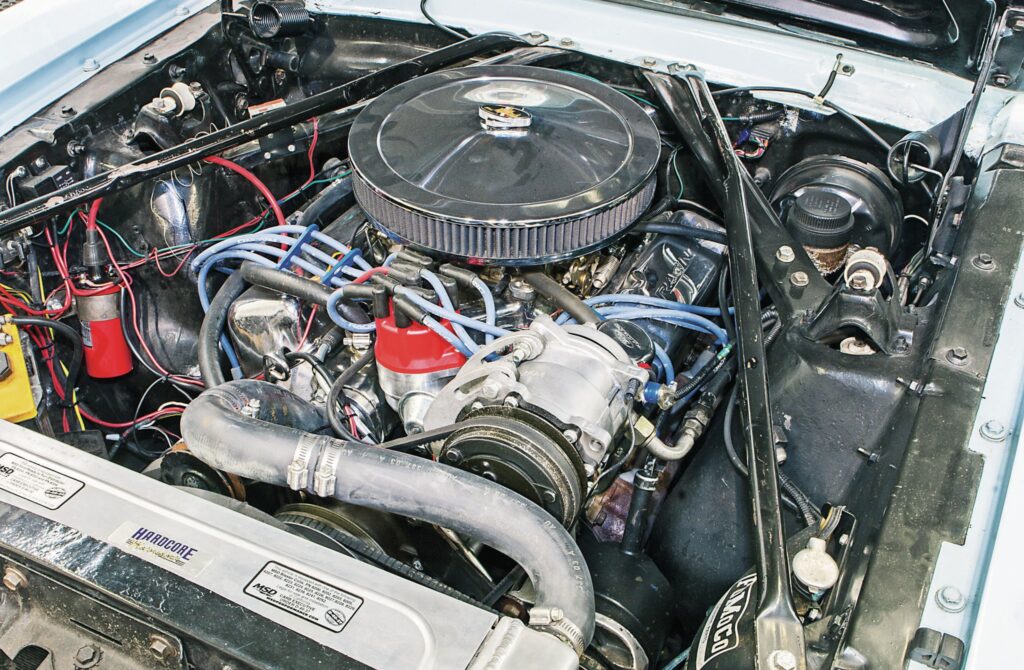If your Mustang is shaking, whether at idle, while driving at higher speeds, or during acceleration, it’s essential to identify the root cause to ensure your car’s safety and performance. From minor issues like unbalanced tires to more serious problems such as engine misfires or faulty suspension parts, understanding why your Mustang is shaking can help you address the issue promptly.
In this guide, we will go over the potential causes of the shaking and provide practical solutions to fix them.

Contents
- 1 Common Causes of Mustang Shaking
- 2 Diagnosing the Shaking in Your Mustang
- 3 Preventive Measures
- 4 Frequently Asked Questions
- 5 Conclusion
Common Causes of Mustang Shaking
Experiencing shaking in the Mustang can be annoying, but identifying the potential causes is the first step in resolving the issue. Here are the most common reasons why your Mustang might be shaking, and how you can address each one.
1. Unbalanced or Damaged Tires
One of the most common reasons for shaking in any vehicle, including the Ford Mustang, is unbalanced or damaged tires. When tires are not properly balanced, the car can vibrate or shake, particularly at higher speeds. Balancing involves adjusting the weight distribution around the tire and wheel to ensure that it rotates smoothly. If this balance is off, it can cause uneven wear and vibrations.
Symptoms:
- Shaking felt at higher speeds: Typically, the vibration is most noticeable when the vehicle reaches 50-70 mph.
- Steering wheel shaking: This is often an indicator of issues with the tires or alignment.
Causes:
- Unbalanced tires: Can occur after a tire replacement or if the tire balance is off.
- Tire damage: A tire that is worn unevenly, bulging, or has a defect can cause vibrations.
Solution:
- Balancing: Have the tires professionally balanced. This can be done at any local tire shop.
- Replace damaged tires: If a tire is too worn or damaged, replace it with a new one to restore vehicle smoothness.
2. Misaligned Wheels
Wheel misalignment is another common cause of shaking or vibrations in your Mustang. When the wheels are not aligned correctly, the car will pull to one side, and the steering wheel might feel off-center. Over time, misalignment can cause uneven tire wear and an uncomfortable driving experience.
Symptoms:
- Steering wheel off-center: If the steering wheel isn’t straight while driving straight.
- Pulling to one side: The car will tend to veer to the left or right without the driver touching the steering wheel.
- Uneven tire wear: One side of the tire wears faster than the other.
Causes:
- Impact from potholes or curbs: Hitting large potholes or curbs can cause the wheels to become misaligned.
- Normal wear and tear: Over time, the suspension system can wear down, causing misalignment.
Solution:
- Wheel alignment: Have your wheels professionally aligned. A wheel alignment ensures that all four wheels are properly positioned for optimal tire wear and handling.
3. Worn Suspension Components
The suspension system plays a key role in maintaining vehicle stability and comfort by absorbing shocks from the road. If any part of the suspension system is worn out, such as shocks, struts, or bushings, it can cause the vehicle to shake or vibrate. A worn suspension system will not be able to absorb the impact from the road as effectively, leading to a rougher ride and potentially excessive shaking.
Symptoms:
- Bouncing or swaying: When driving over bumps, the car may bounce more than usual, or it may sway side to side.
- Rough ride: A noticeable increase in discomfort when driving, especially on uneven surfaces.
- Uneven tire wear: Tires might wear unevenly, which is a clear indicator that the suspension is not working as intended.
Causes:
- Worn shocks or struts: These components help dampen road vibrations. If they are worn out, the car may feel bouncy or unstable.
- Damaged bushings: Rubber bushings wear out over time and lose their ability to absorb vibrations, leading to shakes.
Solution:
- Suspension inspection: Have a mechanic inspect your suspension system for any worn or damaged parts.
- Replace faulty components: If shocks, struts, or bushings are worn, replace them with new parts to restore the ride quality.
4. Engine Misfire or Faulty Engine Mounts
An engine misfire happens when one or more cylinders in the engine fail to fire correctly. This can lead to rough idling and shaking, especially at low speeds or when the vehicle is stopped. Additionally, faulty engine mounts can exacerbate the issue by allowing excessive engine movement, which increases vibrations.
Symptoms:
- Rough idling: If your Mustang shakes when idling or at low speeds, the engine might be misfiring.
- Shaking or vibrations at idle: When the car is stopped, the engine vibrations may be felt through the steering wheel or the car’s chassis.
- Unusual noises: A misfire might also cause a backfire or popping sound from the engine.
Causes:
- Faulty spark plugs or ignition coils: These are the main components that can cause an engine misfire.
- Worn engine mounts: The engine mounts keep the engine in place, and if they are broken or damaged, the engine can shift and cause excessive shaking.
Solution:
- Diagnose the engine: Use an OBD-II scanner to check for error codes related to misfires.
- Replace faulty spark plugs or ignition coils: If these components are damaged, replacing them can fix the issue.
- Check and replace engine mounts: If the engine mounts are damaged, replacing them will reduce engine movement and vibration.
5. Brake Rotor Issues
If your Mustang shakes when applying the brakes, especially at high speeds, the issue may lie with the brake rotors. Warped or uneven rotors can cause vibrations that are felt in the steering wheel or brake pedal.
Symptoms:
- Vibration through the brake pedal: This usually occurs when braking at higher speeds (above 50 mph).
- Shaking steering wheel during braking: The steering wheel will shake or pulse when you press on the brake pedal.
Causes:
- Warped brake rotors: Over time, rotors can become warped due to heat buildup from frequent braking.
- Uneven rotor wear: If the rotors are not properly maintained or replaced, they can develop uneven surfaces.
Solution:
- Brake rotor inspection: Have the brake rotors inspected for warping or damage.
- Resurface or replace rotors: If the rotors are warped, they may need to be resurfaced or replaced entirely.
6. Loose or Damaged Drivetrain Components
Your Mustang’s drivetrain includes components like the driveshaft, axles, and CV joints. If any of these parts are loose or damaged, they can cause vibrations, particularly when accelerating.
Symptoms:
- Vibrations during acceleration: The shaking or vibration will typically become more noticeable when accelerating.
- Unusual noises: If there is a problem with the drivetrain, you may hear clicking or popping sounds.
Causes:
- Worn driveshaft or axles: These components can wear out over time and cause imbalance or damage.
- Damaged CV joints: The CV joints in the drivetrain allow power to be transferred from the engine to the wheels, and they can wear out.
Solution:
- Drivetrain inspection: Have a mechanic check the drivetrain components for wear or damage.
- Replace faulty parts: If any of the components are damaged, they will need to be replaced.

Diagnosing the Shaking in Your Mustang
Properly diagnosing why your Mustang is shaking is the first step toward fixing the problem. Here’s how you can diagnose the issue:
1. Visual Inspection
- Check for damaged tires or uneven wear.
- Inspect suspension parts for visible signs of wear or damage.
- Look for leaks or cracks in the engine mounts.
2. Test Drive
Drive your Mustang and pay close attention to when the shaking occurs. Does it happen only at idle? While accelerating? Or at high speeds?
3. Use Diagnostic Tools
An OBD-II scanner can help identify if there are any engine-related issues like misfires or faulty sensors.
4. Consult a Professional
If you’re unable to pinpoint the issue, or if the problem persists, take your Mustang to a certified mechanic for a thorough inspection.
Preventive Measures
To avoid future shaking issues, follow these preventive measures:
- Regular maintenance: Stick to the recommended maintenance schedule for tire rotations, suspension inspections, and brake checks.
- Prompt repairs: Don’t ignore shaking or vibrations, even if they seem minor. Early detection can prevent bigger problems later.
- Quality parts: Always use quality parts for replacements, such as original equipment manufacturer (OEM) or high-quality aftermarket options.
Frequently Asked Questions
Here are some FAQs about Mustang shaking –
1. Why does my Mustang shake at idle?
Shaking at idle can be caused by an engine misfire, faulty engine mounts, or a vacuum leak.
2. What causes my Mustang to shake at high speeds?
At high speeds, shaking is usually due to unbalanced tires, misaligned wheels, or suspension issues.
3. How can I tell if my Mustang’s tires are unbalanced?
Unbalanced tires cause vibrations at certain speeds, often around 50-70 mph. The steering wheel may shake as well.
4. Can a bad wheel alignment cause my Mustang to shake?
Yes, a bad alignment can lead to vibrations and uneven tire wear, especially at higher speeds.
5. Should I replace my Mustang’s engine mounts if they are worn?
Yes, replacing worn engine mounts can help reduce shaking caused by excessive engine movement.
Conclusion
Shaking in your Mustang can be caused by a variety of factors, ranging from simple issues like unbalanced tires to more complex problems like engine misfires or drivetrain damage. Diagnosing the root cause and addressing it promptly is key to keeping your vehicle running smoothly and safely. By following the recommended solutions and preventive measures, you can reduce the chances of your Mustang shaking and ensure a comfortable driving experience.




